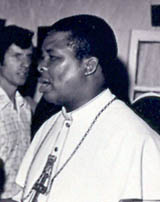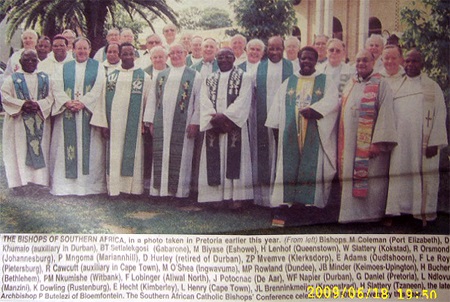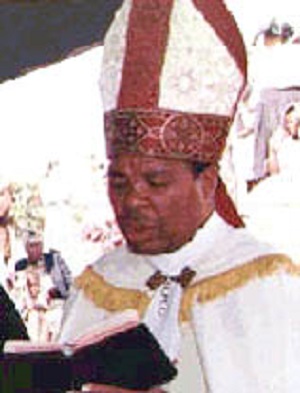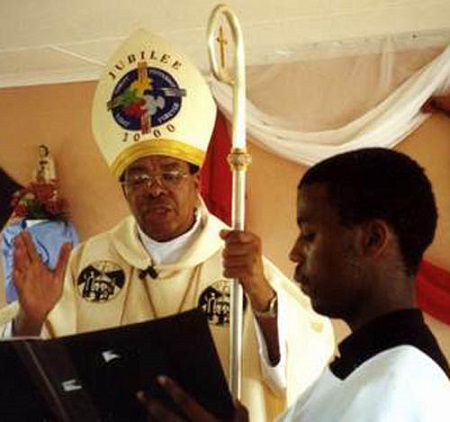Classic DACB Collection
All articles created or submitted in the first twenty years of the project, from 1995 to 2015.Biyase, Dela Mansuet
 Biyase was born on October 5, 1933, near Ixopo in southern Natal. His father was called Michael and worked as a laborer and his mother, Emmarentia Nomagqweta, worked as a domestic servant. Biyase completed his primary school education at Maryhelp Primary School at Ncalu and went on to finish his secondary education at the end of 1954 with a matric certificate from St. Mary’s Minor Seminary, Ixopo. [1] He then went to St. Peter’s Major Seminary to study philosophy and theology as he recalled:
Biyase was born on October 5, 1933, near Ixopo in southern Natal. His father was called Michael and worked as a laborer and his mother, Emmarentia Nomagqweta, worked as a domestic servant. Biyase completed his primary school education at Maryhelp Primary School at Ncalu and went on to finish his secondary education at the end of 1954 with a matric certificate from St. Mary’s Minor Seminary, Ixopo. [1] He then went to St. Peter’s Major Seminary to study philosophy and theology as he recalled:
Yes, St. Peter’s Seminary–that is where I studied. It has its roots in St. Mary’s Minor Seminary which was at one time both a minor and a major seminary. It was built in such a way that it was divided into two: a minor seminary on one side and a major seminary on the other side. In 1945, the minor seminary was separated from the major seminary and transferred to Pevensey near Underberg, Sani Pass, it was then called St. Peter’s Seminary and was run by the Mariannhill Missionaries. Then in 1947, it was taken over by the Bishops’ Conference and it moved to Hammanskraal in 1963 and the Dominican Fathers took over in 1957. [2]
Biyase was ordained a priest for the Diocese of Mariannhill on July 10, 1960. He studied at the seminary when the administration of the seminary moved from the Mariannhill priests to the Dominican fathers as he said: “So when the Dominicans took over the seminary it was during my time and in 1957, Fr. Oswin Magrath was my rector. The seminary was later moved to Hammanskraal but it was a black seminary run by white lecturers.” [3] At the same time he developed his second call and studied music by correspondence from 1961 to 1963 at the Royal School of Music, London and acquired his Music Theory Grade VII Certificate. His first assignment as music teacher was at St. Mary’s Minor Seminary at Ixopo.
From 1962 to 1968, he was an assistant parish priest at Kevelaer, Umbumbulu, and Mariannhill. [4] He was also a member of Umbumbulu Community Center from 1966 to 1967. From 1968 to 1971 he was priest-in-charge at St. Joachim’s Mission, Umtwalume and, in 1969, became chaplain to the Catholic Teachers’ Federation. In 1970 and 1971 he founded and was president of Umzinto South Farmers’ Association.
While working as assistant priest he sometimes experienced the effects of apartheid within the church. For instance, he recalled that “One priest one time was going with me and we wanted to sleep at a mission. He went to ask a nun for a place to sleep, she said yes, but retorted and said what about him? (Biyase). I told them not to worry as I was going to the people in the village. So segregation did happen even within the church.” [5]
Furthermore, their training at the major seminar was censored to some extent as Biyase recounted: “When I studied for priesthood in the 1950s, I can still remember at that time the lecturers, teachers, missionaries who would say you don’t need to study this because you will be assistant priests and not priests in charge. So a black priest for the missionaries was supposed to assist a white person to be a subordinate.” [6] In some cases they were treated as inferiors. Another example given by Biyase occurred in the above mentioned period as he narrated:
I once worked with a priest as an assistant priest in the 1960s. In 1966 to be exact! I worked with a priest who, when we ate at table, used to put on his hat during meals. He told me plainly that he was white and that he had to protect his hair because it is not like mine. I have never seen a man eating with a hat on. So I looked for a day when a white man would come and be at table with us. I was an assistant priest I thought to myself that I was going to fix this man. I waited for the right day as I wanted to see if he would eat with a hat on when there was another white man or whether he did that because I was black. So when a white priest came to visit I also got a hat. When we sat at table I was not interested in him I was interested in the hat whether it was going to be there. So we sat at table for lunch and I put on my hat. He did not put on his hat. After the priest left, I still had my hat on and I saw him turning red. We did not talk to each other. He had been wearing a hat for more than a month. So I decided I will wear the hat as long as I want. The following morning he did not wear the hat and that was the end of it. So he learned a lesson. [7]
In 1971 Bishop Elmar Schmid put Biyase in charge of a large parish at Umtwalume in the township of Umlazi and made him vicar general of the diocese. [8] He became well known for his pastoral zeal and his musical talent. [9] When the search began for a suitable candidate for the diocesan see of Eshowe that had become vacant in July of 1973, Rome chose Biyase on February 28, 1975, to become the new bishop. As Biyase recalled:
The bishop had died in 1973, so from 1973 to 1975, Rome was struggling to get a bishop and, at that time, most of the Benedictines were whites with very few black priests. So Rome, at that time, said we think Zululand, which is predominantly Zulu, needs a black Zulu bishop. Within the Eshowe diocese they had no black priests and they looked around and I was in Umlazi. So that is when I left Umlazi and went to Eshowe to become the bishop. [10]
His episcopal consecration took place on June 28, 1975. The apostolic delegate, the cardinal of Cape Town, ten bishops, some sixty priests and about 8,000 people witnessed this event which took place on the Eshowe Show Grounds. Bishop Mansuet Biyase was the third bishop of Eshowe after Bishop Thomas Spreiter (1921-1943) and Bishop Aurelian Bilgeri (1947-1973) both of whom were members of the Benedictine community of Inkamana and are buried at the abbey cemetery in Inkamana. [11]
When Biyase took over the reins, the Diocese of Eshowe had thirty-two Benedictine priests and four Franciscan priests from Europe. There were only four local diocesan priests. Of a total of 212 religious sisters, 122 were from Germany and ninety from Zululand. The church had still all the elements of a missionary church, being almost totally dependent on personnel and financial help from overseas. Therefore, one of Bishop Biyase’s major concerns was to encourage local vocations and to make the church more self-supporting. During the thirty years as bishop of Eshowe he ordained thirty local diocesan priests. By the time of his death, the diocese had over thirty diocesan priests and twenty-two Benedictine priests. Although the number of sisters had decreased since 1975 from 212 to 139, the majority of them–eighty-eight by 2005–were from South Africa and only fifty-one came from Europe. The number of Catholics increased from 45,000 in 1975 to 81,500 in 2005. He almost doubled the number of Catholics in his diocese mainly because of his missionary zeal and endeavors to make the church part of the local community in liturgy and music. [12]
But his strength and talents were not confined to his diocese. He worked tirelessly for the whole church traveling to many countries during the apartheid regime informing the world about the struggle for freedom at home and explaining to them ways in which they could help the South African community.
He was active with the Catholic nurses guild, founded a credit union in his diocese and established parish councils in all the parishes of the diocese. As a sign of recognition of all his engagements for the church and the country the University of Zululand conferred on him the degree of Doctor of Divinity (honoris causa) on May 27, 2000. [13]
Biyase was also actively in activities related to health, HIV/AIDS, and education in his diocese. [14] This aspect was emphasized point in an interview with Fr. Martin Trieb OSB when Biyase said:
There are lots of people dying from AIDS. I am thankful that we have taken up the challenges it were somehow in our diocese and we have the hospice wherein people are cared for. It has been already in motion for a few years now since ‘96 and it has started through the help of the missionary by the name of Father Gérard when he founded a group or an association by the name of Blessed Gérard. Many people have been actually assisted through this and it is of great help in our diocese, I think. It’s known now all over the country as it were and I am happy that is the part of the work of the church that is kind of being demonstrated there. [15]
As a member of the Southern African Bishops’ Conference (SACBC), Biyase served on various commissions. His experience and knowledge was especially appreciated in the Zulu Liturgical Translation Commission of which he was the chairman for many years. Later he served on and chaired several other commissions, among them the commission for social welfare. He represented the bishops of Southern Africa at the Synod of Bishops in Rome in 1977 and later attended various Interregional Meetings of Bishops of Southern Africa (IMBISA) as the delegate for South Africa. [16]
In 1976, he became chancellor of St. Peter’s Major Seminary at a very turbulent time when student unrest caused the temporary closure of the seminary. In his capacity as chancellor he tried to conduct a survey among African clergy to find out what would be the best way to recruit and train local priests. At the same time he opened a minor seminary at Mahlabatini, one of the major parishes in his diocese. In an effort to promote the social message of the gospel in his diocese, he compiled a pastoral letter in 1977 that explained the social teaching of the Catholic church and was mainly meant for English speaking Catholics. More pastoral letters followed in preparation for the Inter-diocesan Pastoral Consultation that was held in Pretoria in 1980.
The preparation for the annual diocesan pilgrimage to Fatima was a major pastoral concern for Bishop Biyase. He made it a highlight in the liturgical calendar and saw it as a means for the spiritual renewal of the diocese. When the Marian Shrine at Ngome became more and more a focal point for pilgrims from within and outside of the diocese, he made arrangements for a thorough investigation of all the events that led to the establishment of the Ngome Shrine. When theological experts found that there was no reason why Ngome should not become a place of pilgrimage:
During 1989, Bishop Manuset Biyase (the local Bishop of Eshowe–the diocese in which Ngome is situated) and Fr. Michael Mayer OSB met with Fr. Paul B. Decock OMI, the chairperson of the TAC (Theological Advisory Commission of the South African Catholic Bishops’ Conference), to discuss the Ngome Affair. At their request, Fr. Paul B. Decock compiled a statement about Ngome in which he said: “There is nothing objectionable in this (the promotion of the sanctuary at Ngome and the veneration of Our Lady under the name of Tabernacle of the Most High). One does not need divine sanction to start a sanctuary and venerate Our Lady. Pilgrimages could be allowed even if we are not sure of the “authenticity”of the visions…The content of the visions is doctrinally acceptable. These views can be put forward in sermons and leaflets.” [17]
Biyase did not only allow organized pilgrimages but even gave permission for a proper church to be built there:
Bishop Mansuet Biyase gave permission for a bigger chapel to be built at Ngome. Fr. Albert Herold who was parish priest of Nongoma started a building fund. Donors from overseas contributed the bulk of the money due to the efforts of Fr. Albert Herold, Fr. Justus Gämperli and Fr. Meinrad Gerstl. Fr. Conrad Heckelsmüller of St. Ottilien (Germany) drew up the plan and Lawton Construction of Durban was given the contract. The church, built in an hexagonal shape, is situated on a solid rock overlooking the Ngome Forest, about fifty metres away from the tiny chapel erected in 1966. [18]
It was understandable that at the beginning, Biyase felt a little bit overwhelmed by the strong presence of expatriate Benedictine Missionaries priests, brothers and sisters in his diocese. But he was deeply aware of the important service they were rendering so that the Catholic Church could take root in Zululand. For over fifty years they had provided the necessary personnel and financial resources. In view of their powerful presence it was quite natural that Biyase was looking forward to the time when his diocese could rely more on local resources. Success in this respect helped to ease tensions that might have existed in some quarters. His visits to the abbey were always highlights for the Benedictine community, and for Biyase himself the visits seemed to become more and more a time when he could relax and enjoy the atmosphere in the cloister. [19]
Whenever possible he also encouraged issues related to the inculturation of Zulu culture into the liturgy. For instance in a mass held at a sports stadium in Durban Biyase stated that parts of the Zulu culture should be used in the Catholic church as it was reported in The Mercury:
The Zulu-speaking majority in the Roman Catholic church in KwaZulu-Natal can now have their say about what form of worship should be used in the church. At an outdoor “inculturation mass” at Kingsmead cricket stadium, Bishop Mansuet Biyase of Eshowe said that the church will have to exercise caution to ensure Africanization of liturgy does not go too far. The mass (attended by about 15,000 worshippers) was designed to incorporate key elements of the Zulu culture, and traditional African musical instruments such as marimbas and bongo drums featured. Members of the amabutho (Zulu regiments) mingled with traditional healers. Bishop Biyase said any prospective changes ought to be examined carefully and should be within the teaching authority of the church. He condemned the non-sacramental use of holy water, incense, and the laying on of hands. [20]
From 2000 onwards Biyase had serious health problems and was repeatedly hospitalized. His health weakened further and, in 2003, he underwent surgery for a triple bypass and also had a pacemaker installed. But he never fully recovered his strength. In April of 2005, he traveled to Germany following an invitation by the Nardini Sisters who were celebrating the 150th anniversary of their foundation. After his return he was visibly exhausted. Poor health prevented him from joining the other bishops of South Africa who went to Rome in June for the ad limina visit. [21]
On June 26, Biyase suffered a massive stroke while visiting relatives in Durban. He was admitted to Entabeni Hospital but remained unconscious until he died on July 1. He was seventy-one years old. A vigil mass was celebrated on Friday, July 15, in the Cathedral of Eshowe. [22] Cardinal Wilfred Napier of Durban celebrated a requiem mass for the deceased on July 16, on the sports ground of the Little Flower School, Eshowe. This was then followed by the funeral inside the cathedral where Biyase is buried. [23]
On July 4, the diocesan consultors met in Eshowe to elect an administrator to take charge of the Diocese of Eshowe until Rome appointed a successor. Fr. Jabulani Ndaba, the parish priest of St. Patrick’s Parish, Empangeni, was duly elected. Later Monsignor Xolelo Thaddaeus Kumalo from the diocese of Bethlehem was appointed by Rome and was consecrated on June 7, 2008 at the Little Flower School, Eshowe. [24]
The death of Biyase marked the end of a period during which the Diocese of Eshowe had made some remarkable progress from a mission church to a local church. He almost doubled the number of indigenous clergy and laity within his diocese and made remarkable contributions to the Catholic Church in South Africa as whole. [25]
George Sombe Mukuka
Notes:
-
Southern African Catholic Bishops’ Conference (SACBC) Media Release Immediate, Pretoria, Wednesday, July 6, 2005. http://www.eshowe.org/biyase.htm (accessed April 19, 2009).
-
Mansuet Biyase, interview by author, April 7, 1997, Eshowe Diocesan Office, tape recording.
-
Mansuet Biyase, interview by author, April 7, 1997, Eshowe Diocesan Office, tape recording.
-
SACBC, 2005.
-
Mansuet Biyase, interview by author, April 7, 1997, Eshowe Diocesan Office, tape recording.
-
Mansuet Biyase, interview by author, April 7, 1997, Eshowe Diocesan Office, tape recording.
-
Mansuet Biyase, interview by author, April 7, 1997, Eshowe Diocesan Office, tape recording.
-
Other positions Biyase held: Secretary of Idamasa (Interdenominational African Ministers Association of SA) 1971 - 1975; Member of YMCA (Africa), Durban, Christian promotions (1972 - 1975); Vice-Charman of Umlazi Ward 2 Advisory Committee (1973 - 1975); Vicar General of Mariannhill Diocese (1974 - 1975); Appointed Bishop of Eshowe Diocese (28 February 1975); Ordained bishop of Eshowe Diocese (28 June 1975); Member of the SACBC(since 1975); Chancellor of St. Peter’s Seminary, Hammanskraal (1976 - 1978) and Chairman of the SACBC Department of Ecumenism (1988 - 1992).
-
SACBC, 2005.
-
Mansuet Biyase, interview by author, April 7, 1997, Eshowe Diocesan Office, tape recording.
-
SACBC, 2005.
-
SACBC 2005.
-
SACBC, 2005.
-
A joint Pastoral Letter of the KwaZulu Natal Church Leaders’ Group and the KwaZulu Natal Christian Council published to mark the World AIDS Conference, Durban, July 9 14, 2000.
-
“Bishop Dr. Mansuet Dela Biyase of the Diocese of Eshowe about the Brotherhood of Blessed Gérard.” Http://bbg.org.za/video/biyase.htm.
-
SACBC, 2005.
-
Paul B. Decock, “The Ngome Visions” 07-05-90; Ngome File. Cedara, Pietermaritzburg.
-
Mary, Tabernacle of the Most High, Ngome, KwaZulu-Natal, South Africa (1955) “The Miracle Hunter,” http://www.miraclehunter.com/marian_apparitions/ approved_apparitions /ngome/index.html (accessed May 1, 2009).
-
SACBC, 2005.
-
The Mercury, August 10, 2000.
-
Diocesan News, August 2005, 1. The visit ad limina means, “technically, the obligation incumbent on certain members of the hierarchy of visiting, at stated times, the “thresholds of the Apostles”, Sts. Peter and Paul, and of presenting themselves before the pope to give an account of the state of their dioceses. The object of the visit is not merely to make a pilgrimage to the tombs of the apostles, but, above all, to show the proper reverence for the Successor of St. Peter, to acknowledge practically his universal jurisdiction by giving an account of the condition of particular churches, to receive his admonitions and counsels, and thus bind more closely the members of the Church to its Divinely appointed head”. ( http://www.newadvent.org/cathen/15478a.htm. Accessed May 5, 2009).
-
SACBC, 2005.
-
Diocesan News, August 2005, 1; see also ICN Independent Catholic News, Durban, July 5, 2005.
-
SACBC, 2005.
-
SACBC, 2005.
Bibliography
A joint Pastoral Letter of the KwaZulu Natal Church Leaders’ Group and the KwaZulu Natal Christian Council published to mark the World AIDS Conference, Durban, July 9 14, 2000.
Diocesan News, August 2005.
Diocesan News, August 2005.
Independent Catholic News, Durban, July 5, 2005.
Mansuet Biyase, interview by author, April 7, 1997, Eshowe Diocesan Office, tape recording.
The Mercury, August 10, 2000.
Paul B. Decock, The Ngome Visions, 07-05-90 (Ngome File). Cedara, Pietermaritzburg. Mary, Tabernacle of the Most High, Ngome, KwaZulu-Natal, South Africa (1955) “The Miracle Hunter,” http://www.miraclehunter.com/marian_apparitions/approved_apparitions/ ngome/index.html (accessed May 1, 2009).
Southern African Catholic Bishops’ Conference (SACBC) Media Release Immediate, Pretoria, Wednesday, July 6, 2005. Http://www.eshowe.org/biyase.htm (accessed April 19, 2009).
This article, received in 2009, was written by Dr. George Sombe Mukuka, a faculty research manager at the University of Johannesburg, South Africa, and 2008-2009 DACB Project Luke Fellow.
Photo Gallery




Bishop Biyase, photo from St. Mary’s Minor Seminary Archives, Mariathal, Ixopo.



